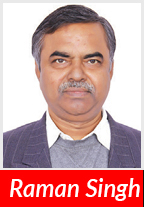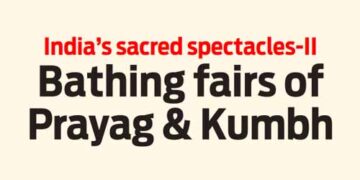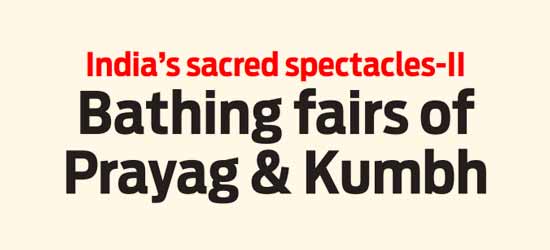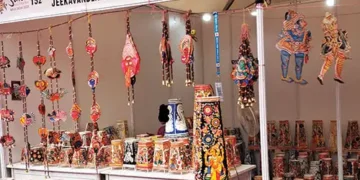 THE humongous public bathing fairs of Prayag are the most hallowed of India’s sacred spectacles. The name itself means the confluence (sangam) of Ganga, Yamuna and Saraswati rivers, famous in myth, legend and history, where the holy bathing carnivals are celebrated viz. the Magh Mela on the eve of Makar Sankranti in mid-January, the six-yearly Ardha Kumbh and the twelve-yearly Purna Kumbh. A dip in the sangam at Triveni, the mythical confluence, supposedly ensures absolution of sins and salvation.
THE humongous public bathing fairs of Prayag are the most hallowed of India’s sacred spectacles. The name itself means the confluence (sangam) of Ganga, Yamuna and Saraswati rivers, famous in myth, legend and history, where the holy bathing carnivals are celebrated viz. the Magh Mela on the eve of Makar Sankranti in mid-January, the six-yearly Ardha Kumbh and the twelve-yearly Purna Kumbh. A dip in the sangam at Triveni, the mythical confluence, supposedly ensures absolution of sins and salvation.
Prayag (erstwhile Allahabad) occupies sacred ground. According to legend, the epic hero Rama was greeted by his brother Bharata at the end of his long exile at a spot in the garden of Anand Bhavan. This meeting is celebrated every year by a procession which ends at the garden. This spot also attracts pilgrims for a different reason: it is the site of Bharadwaj Ashram, named after an ancient seer, where there was a residential university in the olden days.
Old tradition continues
On Sankranti, the first day of annual Magh Mela and on the auspicious days of the Kumbh, the multitude of pilgrims tread for the morning dip at Sangam. As they cheer Mother Ganga (Ganga Mai Ki Jai), their voices beckon to the divine drawing out the power of faith. This mesmerising lure of religion makes us think how for thousands of years the pilgrims marched to Prayag – a testimony to the continuity of tradition, revealing the truth that men may come and go, and governments and empires may lord it awhile and disappear, but the old tradition continues.
It is fascinating to read accounts of these bathing fairs written fifteen centuries ago in Buddhist pilgrim Hiuen Tsang’s description of Kumbh at Prayag. It was ‘an old and hoary mela’ in those times coming from Vedic era. Tsang mentions how Harshavardhan, the emperor of North India, invited all the needy of the ‘five Indies’ to Kumbh and partake of the daily mass feast as his guests. The emperor distributed all the surplus of his treasury at this fair.
Kumbh carnival is the world’s largest single human gathering when millions of Hindu devotees take a bath in the sacred rivers over a course of seven weeks. It is celebrated four times over twelve years, the site of observance changing across four pilgrimage centres on four sacred river spots viz. Haridwar on Ganga, Ujjain on Shipra, Nashik on Godavari, and Prayag on the confluence of Ganga, Yamuna and Saraswati. Each site’s celebration is based on the astrological positions of Sun, Moon and Jupiter, the auspicious time occurring when these positions are fully occupied.
Elixir of immortality
The founding myth of Kumbh, attributed to Puranas, recounts how gods & demons fought over the pot (Kumbh) of elixir of immortality (amrit), produced by their joint churning of the milky ocean. The gods Brihaspati (Jupiter), Surya (Sun), Shani (Saturn) and Chandra (Moon) forcibly seized the pot. The fight for the sacred pitcher between gods & demons continued for 12 divine days (equal to 12 human years) during which drops of elixir fell at above four places. That is why Kumbh is celebrated once in 12 years in these sacred spots when millions take the ritual bath. Adi Shankaracharya instituted the practice of inviting Hindu monastic orders (Akhadas) to Kumbh for discourse, discussion and debate.
Attendees come from all sections, viz. holy men (sadhus), naked mendicants (nagas), hermits (sanyasis), matted ascetics (yogis), and those who leave their isolation only for Kumbh. The thirteen monastic orders claim the holiest spots at each Kumbha’s most propitious moment and their pontiffs (mahants) are the first ones to take the dip. Socio-cultural organisations represented range from NGOs to R&D/management institutions.
The Kumbh at Prayag attracts many millions of pilgrims. The last Ardh Kumbh (2019) attracted 200 million people including 50 million on its most auspicious day. Yogi Adityanath Government allocated Rs 4,200 crore for organising the carnival. The next Purna Kumbh is scheduled for 2025.
































